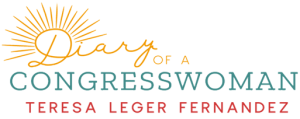Teresa Leger Fernandez:
So today in the life of a Congresswoman, the work I did today was interesting. This week is really a week that the Congress has been dedicated to working on committee work. So on Tuesday I had two committee hearings. One was on public lands, and in that public lands hearing, we had witnesses who came to testify about how our public lands can be used to serve our goals of moving to save our planet. The Conservation Corps was there. I raised with them the idea of creating a cultural Conservation Corps component because of the need to protect our beautiful cultural heritage we have on a lot of our public lands, which are not being protected right now. I went to go visit a site that I might do a bill around to protect an area. And there were petroglyphs that people were just marking out. People were using this area to throw their trash. You know, I saw people doing guns, you know, shooting range just anywhere, they just stop and start shooting. And other people are driving their ATVs, even though there’s roads that driving them off on the side, not on the dirt road. So they’re tearing up wonderful, you know, this very fragile grass. And there’s somebody shooting over there. I was like, Oh my God. But these petroglyphs need to be protected. And there’s a lot of cultural heritage that needs to be protected. So that was wonderful to be able to have this conversation about creating a cultural Conservation Corps. And I’m going to start exploring whether we could put that into a bill and funding and appropriations, and then also talking about how do we do the transition. So that was great, right? That was a great committee hearing.
Mary-Charlotte Domandi
Would the cultural heritage piece be predominantly Native American indigenous or, or is it broader than that? Or what does it look like?
TLF:
No, it’s broader than that because there was a lot of cultural heritage over the last hundreds of years. Hispanos have been in this area, Anglos have been in this area. So there’s a lot of cultural heritage. Some of it’s paleo and burials, like the pictographs, and some of it is more recent. And I think it all speaks to who we are here and that we need to protect this. So we need to protect some of the beautiful old churches and missions that are in places, and so there’s lots of different stuff that needs to be protected, but that’s the kind of stuff that happens at committees. And then the really exciting thing is, you know, that one happens from eight to ten, and then immediately after that, I got to hold the gavel for the very first time, and I was the chairwoman of a committee hearing of the Committee on Indigenous Peoples and Natural Resources. And I need to tell you, it was a great hearing. We had people from Alaska, from Hawaii, from New Mexico area, from the west coast, from Florida, talking about urban Indian issues, all of the different issues that impact Native Americans and indigenous people from COVID. And then not sticking with, okay, this is the horrible thing that we have lived through, but rather these are the things we can start doing. And here is the hopeful note: It was a committee hearing that had Republicans and Democrats in great attendance, and the questioning of the witnesses was focused on the problem and was focused on solutions. And it was the first committee hearing I’ve had where you almost couldn’t tell who was a Republican and who was a Democrat asking the question. Like it was the first time I’ve seen since I’ve been at Congress, a focus on the problem and not on partisanship.
It was just like, wow. And in fact, the ranking member, Don Young of the committee—ranking member means that Republicans, there’s a chair, I’m the Democrat, the chair, and then the ranking member is the highest level Republican, and that’s Don Young. He’s also the Dean of the House, which means he’s been there longer than anyone. He said, “Teresa, Madam Chairwoman, let’s do this. I want to join you,” because I talked about taking action, “I want to join you. Let’s do that big bill.” So we’re going look to see what we can do there. But there was such coordination and such agreement on the problems and that it was horrible and that we needed to do something to meet our trust responsibility. So it’s wonderful. There was complete bipartisanship. You could not tell who was Republican, Democrat. A little bit, the Republican witnesses were pointing out the same problems and pointing out the same kinds of solutions as the Democrat witnesses. And it was just this—it was how things should work. So it was so exciting. I made sure I ran the meeting—you know, I could have started it in a way that could have put people up on the edge because we had just had Boulder happen. And I decided not to do that. I wanted to focus on the issue and that’s what we did. I didn’t raise that we need gun control. Our focus today is on what has happened to Native Americans. Now I will say that’s the only hearing that I’ve ever been at in my whole long tenure of three months in Congress. Every other one, like I was at one today where we just passed out three bills out of Ed and Labor to go to the house floor. One on protecting pregnancy accommodations for pregnant workers, protecting healthcare workers. What do we need to do to protect healthcare workers, and equal pay. And those were just like, how could anybody be against, how could you be against accommodating a pregnant woman with something as little as making sure she’s able to have a water bottle at her workstation so she can stay hydrated? Like those were some of the examples, the examples of the accommodations that we’re talking about. They’re not huge. They’re small accommodations that we couldn’t get Republican votes. We got three Republican votes. I was like, what?
MCD:
Amazing.
TLF:
Amazing, yeah. So that’s my little update on what happens in the life of a Congresswoman in committee hearings.


